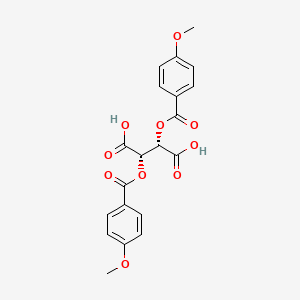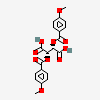(2S,3S)-2,3-Bis((4-methoxybenzoyl)oxy)succinic acid
- 191605-10-4
- (2S,3S)-2,3-Bis((4-methoxybenzoyl)oxy)succinic acid
- (+)-Di-p-anisoyl-D-tartaric Acid
- Butanedioic acid, 2,3-bis[(4-methoxybenzoyl)oxy]-, (2S,3S)-
- (+)-Di-4-Anisoyl-D-tartaric acid
- Create:2006-10-25
- Modify:2024-12-28

- 191605-10-4
- (2S,3S)-2,3-Bis((4-methoxybenzoyl)oxy)succinic acid
- (+)-Di-p-anisoyl-D-tartaric Acid
- Butanedioic acid, 2,3-bis[(4-methoxybenzoyl)oxy]-, (2S,3S)-
- (+)-Di-4-Anisoyl-D-tartaric acid
- Dibenzoyl-(+)-P-methoxy-D-tartaric acid
- (2S,3S)-2,3-BIS(4-METHOXYBENZOYLOXY)BUTANEDIOIC ACID
- MFCD07368366
- (2S,3S)-2,3-bis[(4-methoxybenzoyl)oxy]butanedioic acid
- (+)-Bis(4-methoxybenzoyl)-D-tartaric Acid
- EC 606-247-6
- SCHEMBL935315
- KWWCVCFQHGKOMI-HOTGVXAUSA-N
- DTXSID701304214
- AKOS016843093
- AC-3424
- CS-W008144
- AS-11927
- D3490
- H10779
- EN300-7377917
- (2S,3S)-2,3-bis(4-methoxybenzoyloxy)succinic acid
- (2S,3S)-2,3-Bis((4-methoxybenzoyl)oxy)succinicacid

H315 (100%): Causes skin irritation [Warning Skin corrosion/irritation]
H319 (100%): Causes serious eye irritation [Warning Serious eye damage/eye irritation]
P264, P264+P265, P280, P302+P352, P305+P351+P338, P321, P332+P317, P337+P317, and P362+P364
(The corresponding statement to each P-code can be found at the GHS Classification page.)
Skin Irrit. 2 (100%)
Eye Irrit. 2 (100%)
Skin Irrit. 2 (100%)
Eye Irrit. 2 (100%)
STOT SE 3 (100%)
Patents are available for this chemical structure:
https://patentscope.wipo.int/search/en/result.jsf?inchikey=KWWCVCFQHGKOMI-HOTGVXAUSA-N
- CAS Common ChemistryLICENSEThe data from CAS Common Chemistry is provided under a CC-BY-NC 4.0 license, unless otherwise stated.https://creativecommons.org/licenses/by-nc/4.0/(S,S)-Di-p-anisoyltartaric acidhttps://commonchemistry.cas.org/detail?cas_rn=191605-10-4
- ChemIDplusChemIDplus Chemical Information Classificationhttps://pubchem.ncbi.nlm.nih.gov/source/ChemIDplus
- EPA DSSTox(S,S)-Di-p-anisoyltartaric acidhttps://comptox.epa.gov/dashboard/DTXSID701304214CompTox Chemicals Dashboard Chemical Listshttps://comptox.epa.gov/dashboard/chemical-lists/
- European Chemicals Agency (ECHA)LICENSEUse of the information, documents and data from the ECHA website is subject to the terms and conditions of this Legal Notice, and subject to other binding limitations provided for under applicable law, the information, documents and data made available on the ECHA website may be reproduced, distributed and/or used, totally or in part, for non-commercial purposes provided that ECHA is acknowledged as the source: "Source: European Chemicals Agency, http://echa.europa.eu/". Such acknowledgement must be included in each copy of the material. ECHA permits and encourages organisations and individuals to create links to the ECHA website under the following cumulative conditions: Links can only be made to webpages that provide a link to the Legal Notice page.https://echa.europa.eu/web/guest/legal-notice(+)-Di-p-anisoyl-D-tartaric Acidhttps://chem.echa.europa.eu/100.104.967(2S,3S)-2,3-Bis((4-methoxybenzoyl)oxy)succinic acidhttps://chem.echa.europa.eu/100.127.432(+)-Di-p-anisoyl-D-tartaric Acid (EC: 471-150-6)https://echa.europa.eu/information-on-chemicals/cl-inventory-database/-/discli/details/45181(2S,3S)-2,3-Bis((4-methoxybenzoyl)oxy)succinic acid (EC: 606-247-6)https://echa.europa.eu/information-on-chemicals/cl-inventory-database/-/discli/details/105245
- Japan Chemical Substance Dictionary (Nikkaji)
- NORMAN Suspect List ExchangeLICENSEData: CC-BY 4.0; Code (hosted by ECI, LCSB): Artistic-2.0https://creativecommons.org/licenses/by/4.0/NORMAN Suspect List Exchange Classificationhttps://www.norman-network.com/nds/SLE/
- Wikidata(2S,3S)-2,3-bis[(4-methoxybenzoyl)oxy]butanedioic acidhttps://www.wikidata.org/wiki/Q76411534
- Wiley
- PubChem
- GHS Classification (UNECE)GHS Classification Treehttp://www.unece.org/trans/danger/publi/ghs/ghs_welcome_e.html
- MolGenieMolGenie Organic Chemistry Ontologyhttps://github.com/MolGenie/ontology/
- PATENTSCOPE (WIPO)SID 389682571https://pubchem.ncbi.nlm.nih.gov/substance/389682571

